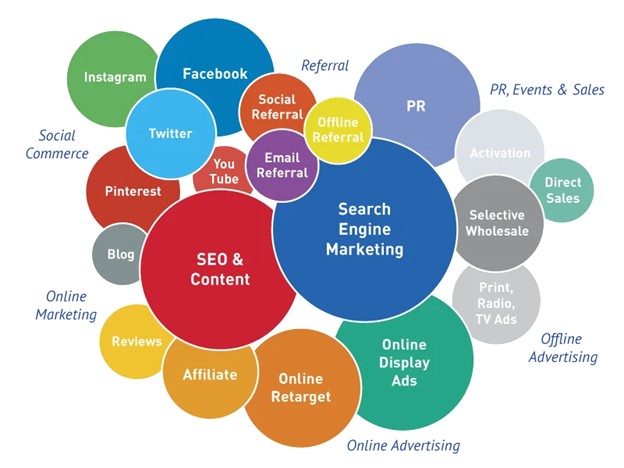Considering that ninety-three percent of all website interactions come about via a search engine, SEO best practices are absolutely crucial in order for businesses to reach customers. However, what happens when your SEO habits clash with your website’s user experience (UX) goals?
This is a question that businesses must answer frequently, as the pursuit of better search engine rankings can often conflict with UX ideals. In order to maximize conversions and keep users happy, it’s important to find a way to balance SEO and UX goals.
To help you find a solution for this common issue, we’ll explore the ways in which SEO and UX can conflict and how to find a balance between the two. We’ll also look at some specific tips for optimizing your website for both search engines and users alike.
SEO and UX Goals: Common Battles
There are a number of conflicts that can arise between departments in your organization – for instance, marketing and sales often butt heads over their strategies.
SEO and UX departments regularly clash, too. This is because, when it comes down to it, their interim goals are often at odds with one another (though they share the ultimate goal of a highly-frequented website).
Let’s take a look at several of the most common battles between SEO and UX goals.
This is a question that businesses must answer frequently, as the pursuit of better search engine rankings can often conflict with UX ideals. In order to maximize conversions and keep users happy, it’s important to find a way to balance SEO and UX goals.
To help you find a solution for this common issue, we’ll explore the ways in which SEO and UX can conflict and how to find a balance between the two. We’ll also look at some specific tips for optimizing your website for both search engines and users alike.
Index-able Content vs. User-Friendly Content
One of the main goals of SEO is to ensure that your website’s content is easily indexed by search engines. This means incorporating keywords and phrases into your text, titling your pages correctly, and using other techniques to make your site as ‘search engine friendly’ as possible.
However, this can often conflict with the goal of creating user-friendly content. Design teams might want to arrange web pages according to the hierarchy of effects, for example, or copywriters might want to write in a more informal style.
Keyword Density vs. Readability and Comprehensibility
Another common conflict between SEO and UX goals is the battle between keyword density and readability. When it comes to SEO, organizations often want to include as many keywords in their content as possible in order to rank higher on search engine results pages.
Another goal, however, is to keep readers spending time on your website. This means ensuring that your content is readable and easily comprehensible. This is where the conflict between SEO and UX goals often arises, as keyword stuffing results in awkward phrases, difficult-to-read text, and a decreased overall user experience.
However, this can often conflict with the goal of creating user-friendly content. Design teams might want to arrange web pages according to the hierarchy of effects, for example, or copywriters might want to write in a more informal style.
Fast Page Loading vs Design and Aesthetics
The loading rate of a website has a surprisingly large impact on its SEO ranking; in fact, around fifty percent of users say they will wait no longer than three seconds for a website to load before abandoning it. This means that, in order to keep users happy, teams need to focus on optimizing your website for fast page loading times.
This makes it difficult for UX/design teams to focus on creating an attractive and visually pleasing website, as high-quality and interactive elements can often slow down the loading process.
So, how can lean companies navigate these common conflicts between SEO and UX goals?

Success Factors in Balancing SEO and UX Goals
Believe it or not, UX and SEO departments do not need to be in conflict; the best way to balance the two is to have both departments work together. With cooperation on each element of web design, it becomes clear that the two disciplines are not in competition but, rather, complementary.
In order for businesses to find success with this balance, there are three key factors best kept in mind:
1. Keyword Usage and Readability Can (and should) Coexist
Although best SEO practices still encourage the use of 1-2% keyword density, it’s no longer necessary to stuff keywords into content in order to rank higher. In fact, if a website is difficult to read because of too many keywords, users will leave in droves – and Google’s algorithm will notice this.
Instead, UX and SEO teams in collaboration can focus on finding the right keywords for websites and using them in a way that is both readable and relevant to your audience. Rather than keyword stuffing, for example, they might harness the power of H1 and H2, or strategically position keywords rather than cranking up their density.
2. Page Design Should be Tailored to the Audience, Not the Algorithm
This is a commonly misunderstood element of web design. Making a user-friendly website isn’t just for the benefit of customers; it’s also to help search engine crawlers better index your website.
In fact, a well-designed website that focuses on the user experience is more likely to rank higher in search engine results pages (SERPs) than one that ignores UX design principles.
This is why many websites feature a blog – it provides an easy way for search engines to index fresh, new content on a regular basis, and eliminates the temptation to create a cluttered and overwhelming layout.
3. Metrics that Matter for UX Must also be Tracked for SEO
A website’s success is not only measured by how well it performs on search engine results pages; it is also judged by how well it meets the needs of its users. Gone are the days when keywords and backlinks were the only metrics that mattered for SEO. Today, user engagement is a key factor in determining a website’s rank.
This is why it’s important to track the same metrics for UX that you do for SEO. By measuring things like time on page, bounce rate, and conversion rate, organizations can get a better idea of how well their website is meeting the needs of users.

Presenting a Case to Management
For those operating within a business that has separate UX and SEO teams, it can be difficult to get them to work together. Often, the two teams operate under different management and have different goals.
In order to get management on board with balancing SEO and UX goals, you’ll need to make a case for why cooperation is important. The following are a few points to emphasize when making your case:
- SEO and UX are not in competition – they work together. Therefore, both teams should be in collaboration.
- A well-designed website that focuses on the user experience is more likely to rank higher in search engine results pages than one that ignores UX design principles.
- By tracking the same metrics for UX and SEO, businesses can better understand how their website is meeting the needs of users. It is best to track both user engagement (metrics like time on page, bounce rate, and conversion rate) and search engine rankings.
- SEO and UX elements have different immediate goals, but they share a common long-term goal: to increase traffic and conversions.
Organizations must toe the line when it comes to balancing budgets, so often, companies will prefer to outsource their UX and SEO strategies. For businesses that want to keep operations in-house, however, the above arguments can help both departments to move toward collaboration.
Demonstrate the Need for Collaborative UX/SEO Goals
When endeavoring to challenge the way your team currently operates, it is important to have a comprehensive understanding of the situation and articulate a clear vision for change. To provide proof that your website is lacking in one or both departments, measure and present the following metrics:
- For UX: Task success rate, time-on-task, error and conversion rates, user satisfaction surveys, recommendations from users
- For SEO: Rankings, organic click-through rates (CTRs), organic search traffic, leads, and conversions from organic traffic
After you’ve gathered and compared data, it is important to contextualize this information with user stories. How do the struggles of individual users reflect in the data?
For example, if task success rates are low, this might be due to a confusing or poorly designed interface. If users are struggling to convert, it could be due to a lack of trust or confidence in the site. The goal is to connect user stories with quantifiable data in order to make a strong case for change.
Final Thoughts
If your website is suffering in terms of UX or SEO, it is crucial to understand that UX goals and SEO goals are best met in collaboration. By measuring and presenting data that reflects the struggles of users and your team’s inability to rank higher, you can make a strong case for change.
For medium-to-large lean teams, a great return on investment is often found by outsourcing both UX and SEO fulfillment to external marketing agencies; however, organizations should still endeavor to understand the implications of UX and SEO collaboration regardless.
In order to successfully work together, both teams need to be on board with the same goal: creating a website that is successful in getting your message in front of your target audience. Whether you outsource to a marketing agency or have an in-house team, a collaborative effort between UX and SEO teams is the key to success.









